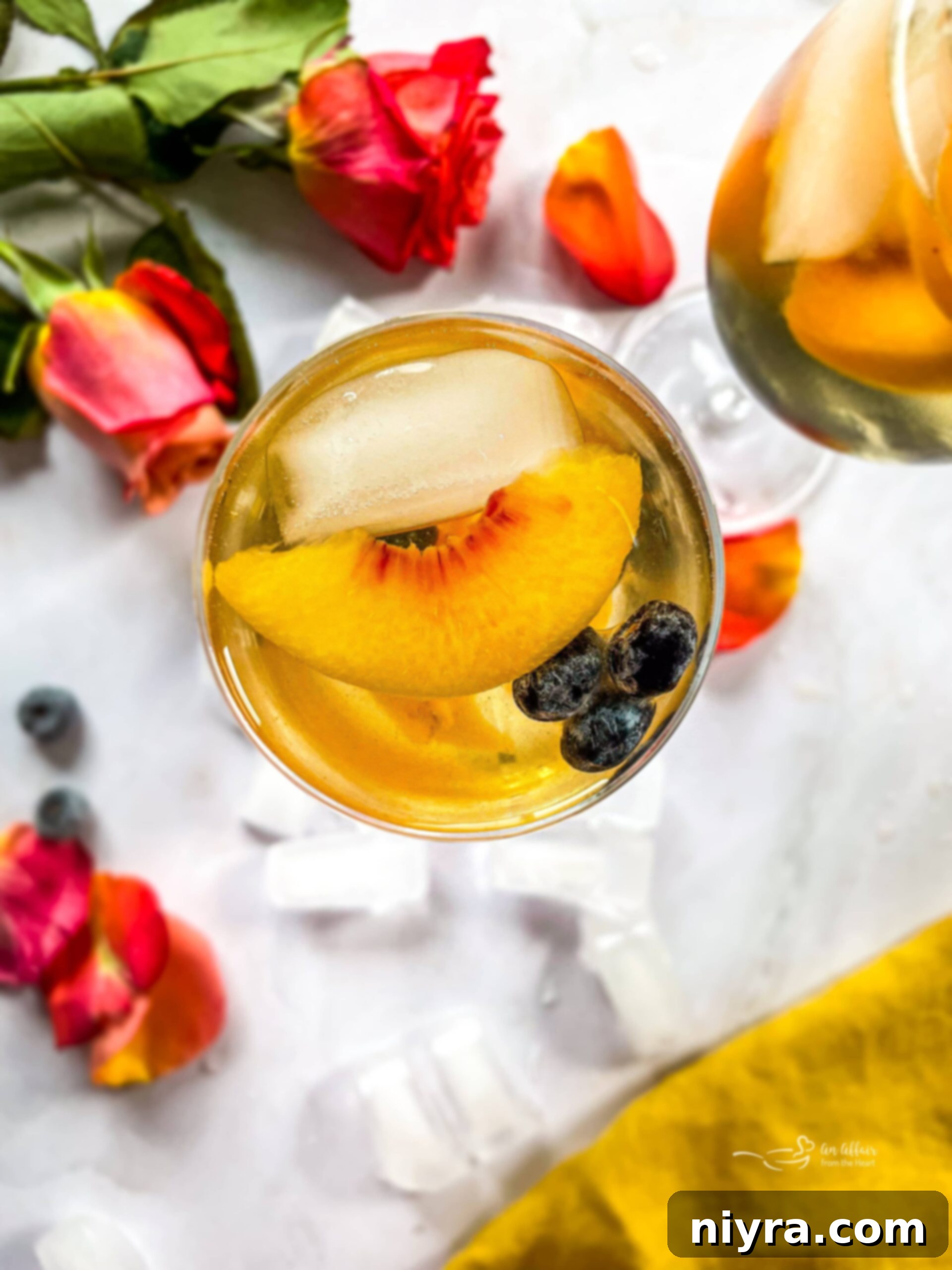Enchanting Rose Sangria: A Refreshing Floral Cocktail Recipe
Welcome to the ultimate guide for crafting the most enchanting Rose Sangria! If you’re searching for a captivating cocktail that combines elegance with irresistible refreshment, you’ve found your new favorite. This unique Rose Sangria recipe features a delicate homemade rose simple syrup, crisp Sauvignon Blanc, and a vibrant medley of fresh fruits, all topped with a delightful fizz from ginger ale. It’s more than just a drink; it’s an experience, perfect for special occasions, warm gatherings, or simply elevating your everyday moments.
Forget the usual; this isn’t your average rosé wine-based sangria. Our Rose Sangria distinguishes itself by incorporating actual rose petals into a custom simple syrup, infusing every sip with a subtle, aromatic floral essence. This thoughtful touch creates a depth of flavor that is truly unparalleled, offering a sophisticated twist on a beloved classic. Whether you’re celebrating Mother’s Day, hosting a brunch, or enjoying a relaxed evening with friends, this easy-to-make pitcher drink is guaranteed to impress.

Why This Rose Sangria Stands Out
In a world of countless sangria variations, our Rose Sangria offers a distinctive profile that sets it apart. Many “rosé sangrias” simply use rosé wine as their base, which, while delicious, doesn’t capture the true essence of rose. This recipe, however, champions the delicate flavor and aroma of real rose petals, creating a truly unique simple syrup that becomes the heart of the cocktail.
The combination of the floral rose syrup with a dry, crisp white wine like Sauvignon Blanc creates a beautifully balanced beverage that is neither overly sweet nor overwhelmingly alcoholic. The addition of ginger ale just before serving provides a cheerful effervescence, making each sip a light and airy delight. It’s an unexpectedly elegant drink that’s incredibly easy to make, yet tastes like something from a high-end cocktail bar.
This recipe isn’t just about taste; it’s about presentation and experience. Imagine a pitcher glistening with vibrant fruit and a hint of delicate rose petals, ready to be poured into chilled glasses. It’s a feast for the eyes as much as it is for the palate, making it a fantastic centerpiece for any celebration.
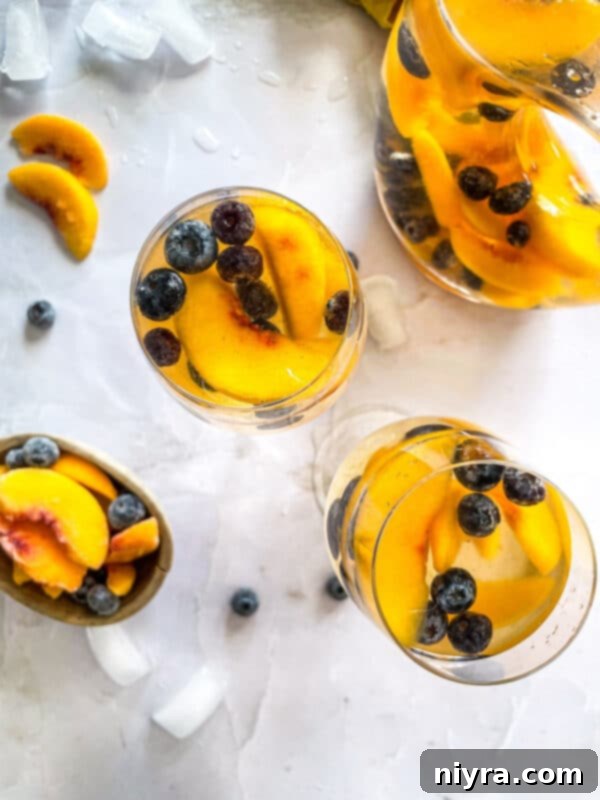
The Story Behind This Beloved Rose Sangria Recipe
This delightful Rose Sangria first charmed its way into my heart (and my guests’) back in 2012 for one of my annual Valentine Girlfriend Brunches. It was an instant hit, quickly becoming a go-to favorite that I’ve lovingly prepared countless times over the years. From intimate gatherings to lively celebrations, this recipe has always delivered smiles and delightful sips.
With the arrival of warmer weather and special occasions like Mother’s Day, it felt like the perfect moment to revisit and share this sensational recipe with you all. Its vibrant flavors and refreshing bubbles are truly what the season calls for. Whether you’re planning a festive brunch or simply seeking a sophisticated drink to enjoy on a sunny afternoon, this Rose Sangria is guaranteed to make your weekend (or any day!) feel a little more special.

Essential Ingredients for Your Rose Sangria
Crafting the perfect Rose Sangria begins with selecting quality ingredients. Here’s a detailed look at what you’ll need and why each component is crucial for the optimal flavor profile:
- Granulated Sugar: This forms the base of our homemade simple syrup, dissolving effortlessly to create a sweet foundation. While white granulated sugar is standard, you can experiment with organic cane sugar for a slightly different note.
- Water: Plain tap water works perfectly for boiling the sugar and steeping the rose petals. No need for anything fancy here!
- Fresh Rose Petals: This is the star ingredient that gives our sangria its unique “rose” character. Choose large, fragrant roses (any color will do, though lighter petals might create a more subtle hue in the syrup) from a reputable source, ensuring they are free from pesticides. Using all the petals from one large rose provides a lovely, distinct flavor without being overpowering.
- Sauvignon Blanc Wine: A crisp, dry white wine like Sauvignon Blanc is ideal for this recipe. Its bright acidity and sometimes grassy or citrusy notes complement the floral rose beautifully without competing. However, don’t hesitate to use your favorite dry white wine. For those who prefer a different profile, a dry rosé wine or even a light-bodied red can be substituted for a unique twist, though the overall character will shift.
- Fresh Fruit of Choice: The beauty of sangria lies in its versatility with fruit. For this batch, I used fresh peaches and blueberries, which offer a delightful sweetness and contrasting colors. Other excellent choices include strawberries, raspberries, blackberries, orange slices, or even a mix of frozen berries for convenience. The fruit not only adds flavor but also absorbs the wine, becoming wonderfully infused.
- Ginger Ale: Added just before serving, ginger ale provides the essential sparkle and a touch of zesty ginger flavor that truly brightens the entire drink. You can also use sparkling water, lemon-lime soda, or even club soda if you prefer a less sweet or different flavor profile.
Step-by-Step: How to Craft Your Perfect Rose Sangria
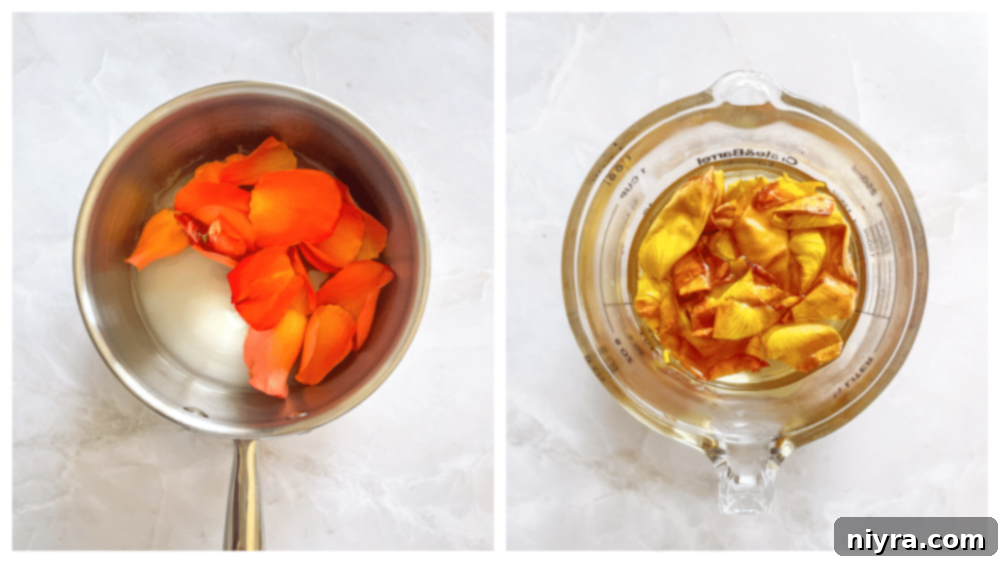
Follow these simple steps to create a show-stopping Rose Sangria that will delight your senses:
- Prepare the Rose Simple Syrup: In a small saucepan, combine the water, granulated sugar, and fresh rose petals. Place the pan over medium heat and bring the mixture to a gentle boil, stirring occasionally until the sugar completely dissolves. Once boiling, remove the saucepan from the heat.
- Steep the Rose Petals: Allow the rose petals to steep in the hot sugar syrup for approximately 15 minutes. This crucial step allows the petals to release their delicate aroma and flavor into the syrup, creating the distinctive rose essence.
- Strain and Cool the Syrup: After steeping, carefully strain the simple syrup to remove the rose petals. Discard the petals. You now have a fragrant homemade rose simple syrup! Set it aside to cool completely before proceeding.
- Combine Ingredients for Infusion: While the syrup cools, wash and prepare your chosen fresh fruit, cutting it into bite-sized pieces if necessary. Place the chopped fruit into a large, airtight pitcher or container. Pour the cooled rose simple syrup and both bottles of Sauvignon Blanc wine over the fruit.
- Refrigerate for Flavor Development: This is a critical step for optimal flavor. Cover the container tightly and refrigerate the sangria mixture for a minimum of 24 hours. This extended chilling period allows the fruit to beautifully infuse its flavors into the wine and syrup, creating a harmonious and delicious blend. Give it a gentle stir occasionally to help the flavors mingle.
- Serve with a Sparkling Finish: Just before you’re ready to serve, transfer the infused sangria mixture into a beautiful pitcher or punch bowl. Pour a can of chilled ginger ale over the top to add that wonderful bubbly effect and a hint of zesty ginger. Serve immediately over ice.
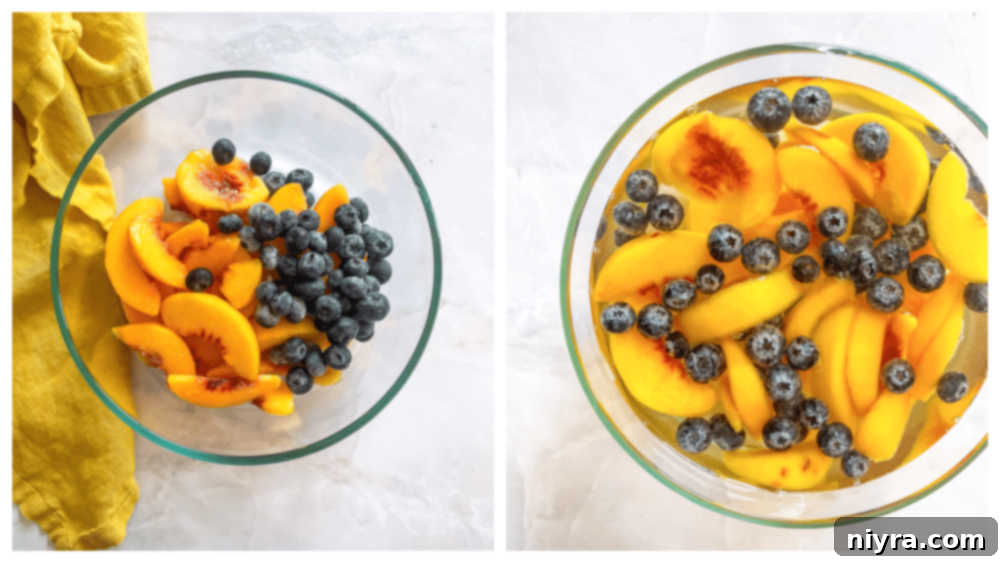
This Rose Sangria is best enjoyed fresh, but leftovers can be stored in the refrigerator for up to a week. Simply cover the container tightly with plastic wrap. Freezing is not recommended as it can alter the texture and flavor of the fruit and wine.

Frequently Asked Questions About Rose Sangria
Curious about Rose Sangria? Here are answers to some common questions:
What exactly is in Rose Sangria? This particular Rose Sangria is uniquely crafted with a simple syrup made from water, sugar, and actual fresh rose petals, infused with a crisp white wine (like Sauvignon Blanc) and fresh fruit, then topped with ginger ale.
What gives pink sangria its color? Pink sangria typically gets its color from using red wine, sometimes mixed with white wine, or by using a rosé wine. Our Rose Sangria, while often having a lovely light hue from the fruit and wine, gets its name and floral essence from the rose petals, not necessarily its color.
What’s the difference between red and rose sangria? Traditional red sangria is made with red wine and often features bolder fruits. Rosé sangria uses rosé wine. This specific Rose Sangria distinguishes itself by incorporating real rose petals for a floral flavor, often paired with a white wine, offering a lighter and more aromatic experience compared to its red counterpart.
Is sangria typically stronger than wine? No, sangria is generally not as strong as pure wine. The addition of fruit, juice, and sparkling mixers like ginger ale dilutes the alcohol content, making it a lighter and more refreshing beverage. Pure wine, undiluted, naturally has a higher alcohol concentration.
Can I use any color of rose petals for the simple syrup? Absolutely! Any color of fresh, unsprayed rose petals will work beautifully. While the color of the petals might slightly influence the hue of your simple syrup, it will not affect the delicate rose flavor at all.
Is it possible to make this sangria without alcohol? Yes, you can easily create a delicious non-alcoholic version! Simply substitute the Sauvignon Blanc with sparkling cider, white grape juice, or even a non-alcoholic white wine alternative for a family-friendly mocktail.
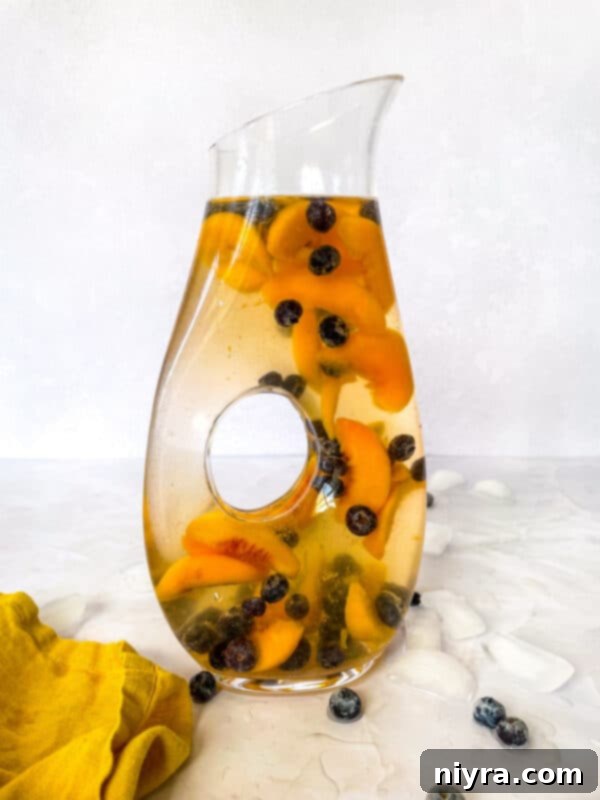
Creative Substitutions & Variations for Your Rose Sangria
One of the joys of making sangria is its adaptability. Feel free to get creative and customize this Rose Sangria to your taste:
- Wine Alternatives: While Sauvignon Blanc is recommended, explore other dry white wines like Pinot Grigio or Chardonnay. For a different twist, try a dry rosé or even a light-bodied red wine for a deeper flavor profile. For a completely non-alcoholic version, sparkling cider, white grape juice, or non-alcoholic wine are excellent choices.
- Fruity Infusions: Beyond peaches and blueberries, consider adding sliced strawberries, raspberries, blackberries, mango, orange, lemon, or lime slices. Frozen fruit can also be used, acting as natural ice cubes that won’t dilute your drink.
- Sparkling Mixers: Instead of ginger ale, use sparkling water for a lighter touch, or lemon-lime soda (like 7Up or Sprite) for added sweetness and citrus notes. Club soda is another great option for just effervescence without much added flavor.
- Juice Boosters: For extra depth of flavor, stir in a splash of fruit juice like apple, pineapple, or cranberry juice. A touch of freshly squeezed lemon or orange juice can brighten the flavors considerably.
- Liqueur Enhancements: To elevate the cocktail’s complexity and alcohol content, consider adding a splash of orange liqueur such as Triple Sec, Grand Marnier, or Cointreau. A hint of elderflower liqueur would also beautifully complement the rose notes.
- Warm Spices: For a cozy variation, particularly in cooler months, infuse the sangria with warm spices like a cinnamon stick or a vanilla bean during the chilling process.
- Garnish Galore: Beyond the fruit, elevate your presentation with fresh herbs. Sprigs of fresh mint or basil add an aromatic flourish and visual appeal to each glass. Edible rose petals also make a stunning garnish.
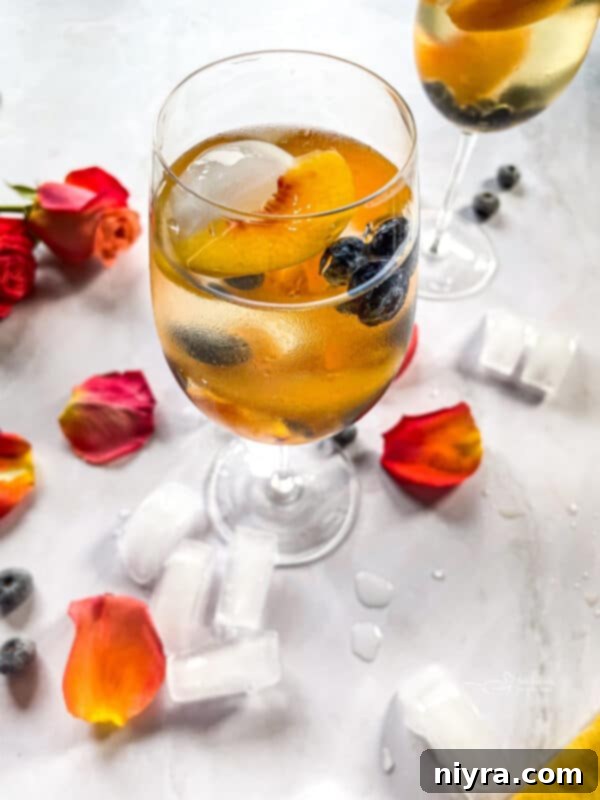
Expert Tips & Tricks for the Best Rose Sangria
To ensure your Rose Sangria turns out perfectly every time, keep these tips in mind:
- Prioritize Chilling Time: Do not rush the refrigeration step! The 24-hour chilling period is absolutely crucial for the delicate rose and fruit flavors to fully meld and develop. This infusion time makes all the difference in achieving a rich, complex taste.
- Fresh vs. Frozen Fruit: While fresh fruit is always lovely for its texture and visual appeal, frozen fruit is a fantastic alternative. It’s convenient, readily available, and acts as natural ice cubes, keeping your sangria perfectly chilled without diluting its flavors.
- Choose Unsprayed Roses: When using real rose petals, ensure they are food-grade and free from pesticides. Purchase them from a specialty food store, a farmer’s market, or use roses from your own garden if you know they haven’t been treated with chemicals.
- Taste and Adjust: Before serving, always taste your sangria and adjust sweetness or acidity if needed. A splash of lemon juice can brighten it up, or a little extra simple syrup can sweeten it.
- Chill Your Glasses: For an extra refreshing experience, chill your serving glasses in the refrigerator or freezer for a few minutes before pouring the sangria.

More Floral & Fruity Recipes to Love
If you’ve fallen in love with the idea of incorporating flowers into your culinary creations or simply enjoy vibrant, refreshing drinks, you’ll adore these:
- Fun Ways to Use Rose Petals in the Kitchen:
- Rose Champagne Cocktail: Another elegant rose-infused beverage.
- Rose Ice Cream: A delightfully fragrant dessert.
- Homemade Rose Water: A versatile ingredient for cooking and beauty.
- Rose White Hot Chocolate: A comforting and aromatic treat.
- Favorite Large-Batch Cocktails for Celebrations:
- Blueberry Margaritas: A fruity twist on a classic.
- Frozen Vodka Slush: Perfect for hot days.
- Brazilian Lemonade: A creamy, zesty, and refreshing drink.
- Love Using Flowers in Your Kitchen? Try These:
- Lavender Shortbread with Strawberries and Cream: A delicate and aromatic dessert.
- How To Flavor Sugars: Creative ways to infuse sweetness.
- Homemade Sugar Scrubs: Not for eating, but a lovely use of natural ingredients!
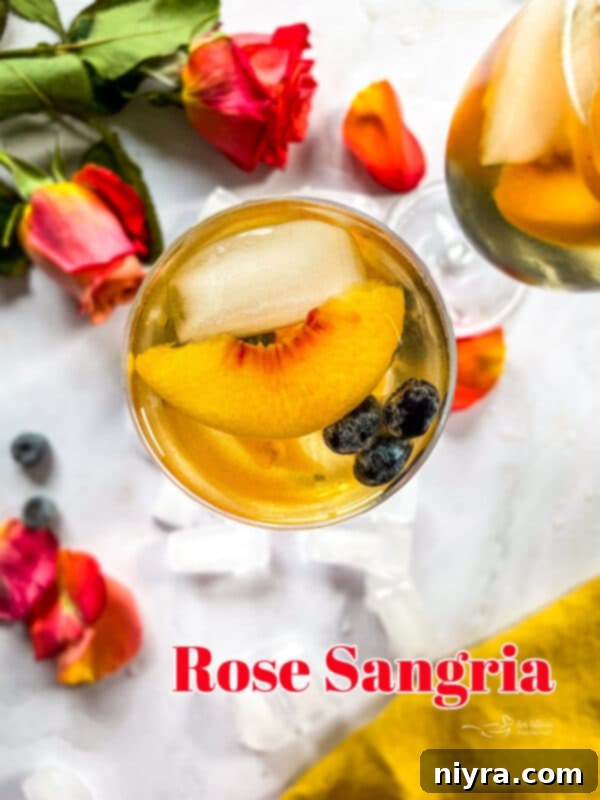
Conclusion: Your New Favorite Refreshment
On a hot summer day, or any day that calls for a touch of elegance and refreshment, a large pitcher of this stunning Rose Sangria is an absolute must. It’s a delightful departure from your everyday white or red sangria, offering a unique fruity and floral flavor that is both sophisticated and incredibly approachable.
This delightful beverage is ideal for any special occasion – from festive Mother’s Day brunches and celebratory gatherings to a cozy girls’ night in or even a bright Christmas morning treat. Its unique flavor profile ensures it will be a memorable addition to your drink repertoire.
Now that the warm weather is upon us, there’s no better time to whip up a large batch and indulge in this exquisitely classic recipe for rose-infused sangria. Gather your ingredients, prepare for the delightful aroma, and get ready to toast to good times. Cheers to you and yours!

Rose Sangria Recipe
LIKE THIS RECIPE?
Don’t forget to give it a ⭐⭐⭐⭐⭐ star rating and
leave a comment below the recipe!

Rose Sangria
This easy recipe for Rose Sangria is made with rose simple syrup, Sauvignon Blanc, and an assortment of fresh fruit and ginger ale for a refreshing cocktail.
Equipment
- HAKEEMI Wine Glasses Set of 12
- Mikasa Napoli Glass Beverage Pitcher
Ingredients
- 2/3 cup sugar
- 2/3 cup water
- The petals of 1 large rose (any color works)
- 2 bottles of Sauvignon Blanc Wine
- 4 cups fruit (fresh or frozen, your choice)
- 1 can (or desired amount) ginger ale, for serving
Instructions
- Over medium heat, bring the water, sugar, and rose petals to a boil in a saucepan.
- Remove from heat and let the petals steep in the water for about 15 minutes to infuse their flavor.
- Remove and discard the petals. You have just created a fragrant rose simple syrup. Set it aside to cool completely.
- Cut up your chosen fruit and place it in a large, airtight container or pitcher.
- Pour the cooled rose simple syrup and the Sauvignon Blanc wine over the fruit.
- Refrigerate the mixture for a minimum of 24 hours. This allows the flavors to properly meld and deepen.
- Just before serving, pour the sangria mixture into a pitcher or punch bowl. Top with a can of ginger ale to add a delightful bubbly effect. Serve immediately over ice.
Notes
- Fruit options: Excellent choices include peaches, blueberries, strawberries, raspberries, blackberries, and oranges. Feel free to mix and match!
- Storage: Leftover Rose Sangria can be stored in the refrigerator for up to a week. Ensure the container is tightly covered with plastic wrap. Freezing this sangria is not recommended as it can compromise the texture and flavor.
Nutrition (per serving)
Serving: 1 | Calories: 193kcal | Carbohydrates: 36g | Protein: 1g | Sodium: 3mg | Fiber: 1g | Sugar: 32g
This Rose Sangria recipe was first published on February 27, 2012, and has been comprehensively updated on May 12, 2023, to enhance user experience and provide richer content.
